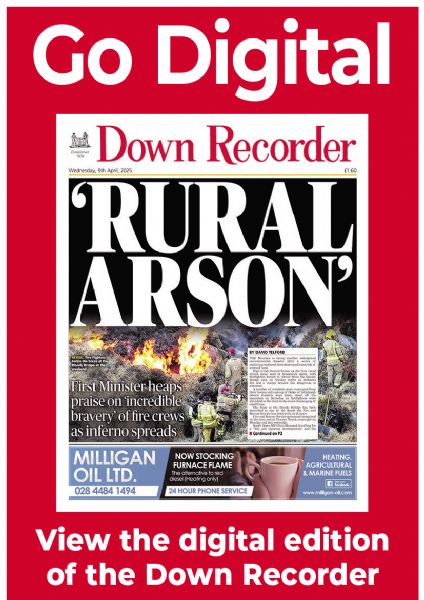‘By grace of God’ lives were not lost in Mournes wildfires
‘By grace of God’ lives were not lost in Mournes wildfires
14 May 2025

A STORMONT Minister believes “it’s only by the grace of God” that not more lives were lost during the recent
wildfires that swept across the Mournes and other parts of the province.
A series of malicious fires were started across the mountains last month with significant damage in the Bloody Bridge and Silent Valley areas.
During an Assembly debate, Environment and Rural Affairs Minister Andrew Muir said the “overwhelming majority” of recent rural fires in the region had been started deliberately.
Firefighters in Northern Ireland dealt with almost 300 wildfires in a single week last month.
Mr Muir was asked about the fires during ministerial question time at the Northern Ireland Assembly on Tuesday of last week.
He described the recent spate of wildfire incidents as “very concerning” explaining they not only have the potential to have devastating impacts on the environment, but also pose a risk to life, homes and farms.
Mr Muir, who described the fires as “deliberate acts of rural arson,” said his engagement with the Fire and Rescue Service revealed the overwhelming majority of blazes had been deliberately set.
“It is only by the grace of God that no-one has been killed in Northern Ireland as a result of these fires and I would urge anyone who has any information to pass that on to the police,” he said.
“We have to be very clear around our attitudes to these fires. They are not something we should see as headlines that come and go, they are something we need to have a different attitude towards.
“We need to have an attitude that if we know anyone who was lighting these fires, we have to contact the police and we have to be prepared to give evidence to take it to court.”
Mr Muir, who recently met some of the local firefighters who tackled the blaze in the Mournes,
described scenes of damage caused to rural areas by fire as “very distressing”.
And he’s highlighted the need to be conscious that what people may see as a localised fire can very quickly spread and can have devastating consequences
“We all have a role as elected representatives to profile those communications and to encourage people with any information to bring it to the police because we need prosecutions around this, we need to see people in court,” continued Mr Muir.
“But that requires people who are prepared to give evidence.”
In response to members’ questions, Mr Muir highlighted the need for everyone to be conscious that what people may see as a localised fire, can very quickly spread and can have devastating consequences.
Mr Muir added: “People need to be very conscious of their behaviour in the countryside because we have seen other parts of the world where people have lost their lives. That is my concern around this.”
Two weeks ago, the National Trust warned that four years on from the devastating fire that ravaged the Mournes in 2021 and the spate of wildfires in April, that it will take years for the precious landscape to recover.
The warning is at the heart of a new report on the condition, recovery and approach to managing its land within the Mournes which the conservation charity has launched.
The ‘Donard Nature Recovery Report’ highlights the fragility of the delicate habitats in this area and outlines the condition of the land, particularly following the fire in April 2021 which destroyed 720 acres which was transformed into a lunar landscape.
An area once brimming with flora and fauna was scorched, vegetation destroyed and species diversity reduced.
The conservation charity revealed that wildfire recovery monitoring using Environment Agency
condition assessments between 2021 and 2024 found quick recovery of grasses and more gradual recovery of dwarf shrubs.
In addition, a so-called wildfire regime analysis by the Pau Costa Foundation in 2023 outlined the potential dynamics of future wildfires across the Mournes and highlighted areas where strategic management would reduce flame length and the rate of spread of wildfire.
This work also highlighted the impacts of climate change on wildfire dynamics, emphasising the need for strategic management to prevent such devastating wildfires onsite in the future, while the Montane Heath Condition Assessment in 2022 covered the fragile montane heath on the summit of Donard and Commedagh.
The conservation charity’s conservation adviser, Melina Quinn, said the 2021 fire has had a “devastating and lasting impact” on the surrounding environment.
She said this land is a “precious and scientifically important area” home to a rich variety of wildlife and habitats that need care.
She added: “This report highlights that nature is being subjected to a myriad of threats and pressures from recreation, burning, grazing, ammonia deposition, land use changes and climate change.
“We now have evidence of catastrophic declines in invertebrates following the 2021 wildfire; a change on this scale, three years after the initial burn provides evidence of a significant ongoing impact. This, in addition to the unfavourable condition of our priority habitats, is extremely worrying.”


